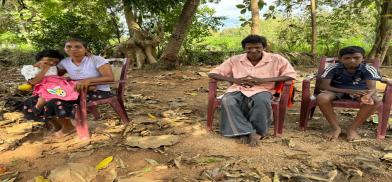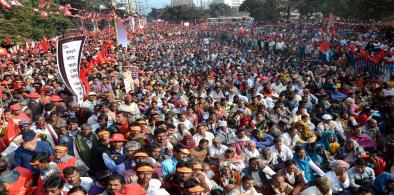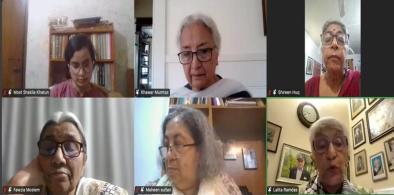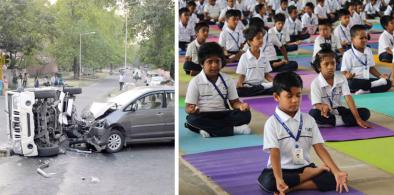Sri Lankan vignette: Grassroots education thrives amid rural poverty
With free education for all between five to 16 years instituted since 1945, Sri Lanka boasts the highest literacy rate, nearly 99 per cent , in the South Asian region.

In Sri Lanka, where I spent some time recently on a reporting trip supported by the Pulitzer Center, presidential elections must be held before 6 October this year. Stories of economic hardship echo from the island nation’s largest city Colombo to the farming heartlands around Anuradhapura district, at the core of the island's rice-growing North-Central Province.
It takes us nearly five hours to get there on surprisingly good roads - testament to the rural infrastructure built after the end of a 26-year long civil war. We stayed for several days in Dutuwewa, a 'purana gama' or ancient village, supported by a historic irrigation tank built by kings thousands of years ago. Some 14,000 such large and small ancient 'wewas' dot Sri Lanka's 'dry zone'.
The serene wewas, lush paddy fields and dense forests are a world away from the corridors of power and the air-conditioned high-rises of Colombo or its historic colonial buildings left behind by 500 years of colonizers - the Dutch, the Portuguese and the British.
As the country recovers from the biggest economic crash in its history, the Sri Lankan rupee has come down from nearly 350 to the dollar to around 300. This is now about the same rate as in my home country Pakistan, still facing an economic crisis.
A village school in a forest
The din of crickets from the surrounding forest forms the backdrop to everything in Dutuwewa. The headmistress of the Palugollagama government school, who gives only her initials and last name, I. R. Ekanayake, is an 'old girl' who has taught at schools around the district for 26 years. She was posted as principal to her alma mater four years ago.
The school, with two vice principals, 36 teachers and 506 students, runs from kindergarten to grade 13 or 'A' levels. The teachers and students all belong to local farming families.
Some have lived here for centuries, others are 'settlers' from various castes, each family provided one acre of paddy and three acres of dry land in the 1950s. Their influx did not upset the homogeneity of the area, where a syncretic culture prevails. Statues of King Mahasena (277–304 CE), who built many of the area's wewas, are deified as much as representations of the Buddha that sometimes share shrine space with the Hindu deity Ganesh.
Teachers and parents at the Palugollagama school converted a bicycle shed on the hillside into a shared space for grades 7-8. There are no fans, but a breeze eases the oppressive heat and humidity. Solar panels at the entrance of the school power light bulbs.
We witness an impromptu bird rescue, as villagers work together to get a bewildered owl back into his perch in a cluster of trees. It sits quietly on the dirt below, having apparently fallen out during the heat of the day. Worried about the crows and dogs, one man throws a blanket over it from behind, and another climbs the tree with the bird under his arm.
The confused owl flaps back to the roadside. The villagers good-naturedly repeat the exercise, this time throwing the blanket-wrapped owl up to a boy now perched himself up higher on the tree. Deftly catching the owl-bundle, he wedges it in again.
Politicians only come here at election time and no teacher can survive on the government salary, the teachers tell me. They survive because they are all also farmers and most of them own land. Despite the challenges, the school boasts a high rate of achievement, competing in national athletics and football tournaments.
The sweeping reforms from the sixties onwards by successive governments in Sri Lanka, and the extra weightage to students from rural backgrounds ensure that several students a year go on to university. With free education for all between five to 16 years instituted since 1945, Sri Lanka boasts the highest literacy rate, nearly 99 per cent , in the South Asian region.
Parent-teacher unity
The village school struggles for resources, says Principal Ekanayake. "Everything you see here is the work of parents, the result of unity between parents and teachers." When the roofs get damaged, the parents who help rebuild them. Asbestos - cheaper, maintenance-free, has replaced the traditional, climate-friendly red shingles.
Amila Sampath, 30, a local farmer accompanying us has a five-year-old daughter in this school. Mrs Ekanayake was once his teacher at another school. If he was president or prime minister, he would reform education, he says. "People don't vote wisely. I would enhance knowledge of political systems. This country is being mishandled by old people."
Nearly a quarter (24.9 per cent) of Sri Lanka's population was under 15 years old at the start of this year. It was the youth that led the popular uprising against the previous government, forcing president Gotabaya Rajapaksa and his brother Mahinda, the prime minister, out of power.
A family living down the road from the house we're staying at comes to visit - they had never seen "a foreigner" before. The daughter, six-year-old Jayani, studies in class 2 at the Palugollagama school. She saw our white van go past their shack and dragged her family, all barefoot, over to meet me.
They are desperately poor, our hosts tell us. Teachers at the school have given them plastic sheets to protect them from the weather. Jayani stays perched on her mother Indira Kumari's lap. Her father Ajit Kumara says he's 45 but looks older. Jayani's brother Kavishka Madhu, 13, goes to a temple school, which he prefers because it's 'easier'.
"He's a good dancer," volunteers Indira, 35. Her smile fades as she mentions her own mother, paralysed and bedridden. Ajit Kumara's aged parents live with them too. Like everyone else here, they are farmers - but have no land of their own.
Kavishka wants to be a policeman when he grows up. And Jayani? "Doctor", she whispers after a pause.
Long way to go
As the barefoot family leaves, I wonder if their dreams will come true. Despite the difficulties, Sri Lanka's rural students do reach universities and follow professional careers. What counts against them is the lack of English and computing skills.
Rishma, a lanky teenager cycling up and down the dirt path bounding the paddy fields tells me in halting English that she studies in class 10 at a nearby girls' college. She knows about my visit to the Palugollagama school as her sister Hashini studies there, in class 3.
Pixie-like, Hashini materialises next to me. She unexpectedly takes my hand in firm grip and walks with me to where my video crew is filming farmers at work. I marvel at her trotting barefooted beside me - I could manage only a few steps without my slippers.
Paddy birds swirl, strut and swoop into the sheets of water lying across the fields, disturbing the glistening mirror reflection of the sky and clouds, and the lush green lines of the planted trees and bushes.
Rishma grabs my other arm so I put away my phone, notebook and pen and take her hand too. We walk along the dirt path towards the film crew. "My father... My house", says Rishma, pointing to a bare-chested man working in a field by a house. She invites me in to meet her mother. Sadly, we must leave to conduct an interview before the evening light fades.
These glimpses into the stories of farmers, teachers, and children in a remote village over a year after the economic collapse in Sri Lanka indicate that while the situation is improving, there is a long way to go before the people’s aspirations can be met.
(The writer is the Boston-based founder and editor of Sapan News, in Sri Lanka for a reporting project supported by the Pulitzer Center. By special arrangement with Sapan)
<a href="https://mods-menu.ru/arkady/302-pogruzis-v-penguin-rescue-2-player-co-op-na-android-ekshen-dlya-nastoyaschih-geymerov.html">Скачать МОД Penguin Rescue: 2 Player Co-op на Андроид</a> предлагает захватывающий и разнообразный геймплей, который не даст скучать. Игра представляет в себе элементы головоломок, предоставляя геймерам множество приключений и миссии. Вы сможете управлять персонажем, проходить сложные миссии, сражаться с врагами и разгадывать загадки игрового мира. Удобное управление и интуитивный интерфейс позволяют быстро влиться в игру, независимо от уровня подготовки игрока.
Web: https://mods-menu.ru/arkady/302-pogruzis-v-penguin-rescue-2-player-co-op-na-android-ekshen-dlya-nastoyaschih-geymerov.html
Графика в Penguin Rescue: 2 Player Co-op создана на отличном уровне. Разработчики надеялись создать прекрасный и живописный мир, который хочется исследовать. Тщательно проработанные модели персонажей, красочные оттенки и натуральные анимации превращают каждую сцену реалистичной и захватывающей. Световые эффекты и тень создают дополнительный уровень реализма и правдоподобие, создавая мир, которая притягивает внимание и увлекает в игровое пространство.



















Post a Comment